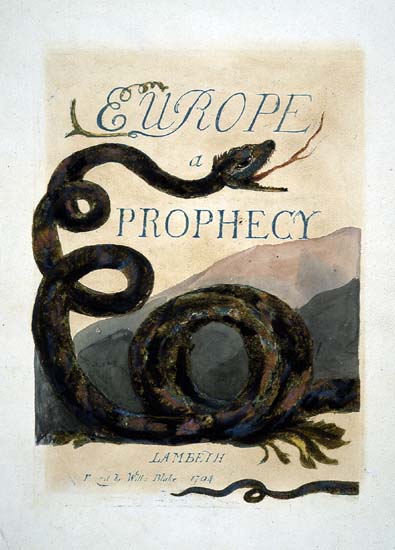First posted, January 2013 as LIFE OF CHRIST XX.
John 19
[25] Now there stood by the cross of Jesus his mother,
and his mother's sister, Mary the wife of Cleophas, and Mary
Magdalene.
[26] When Jesus therefore saw his mother, and the disciple
standing by, whom he loved, he saith unto his mother, Woman, behold
thy son!
[27] Then saith he to the disciple, Behold thy mother! And
from that hour that disciple took her unto his own home.
[28] After this, Jesus knowing that all things were now
accomplished, that the scripture might be fulfilled, saith, I
thirst.
[29] Now there was set a vessel full of vinegar: and they
filled a spunge with vinegar, and put it upon hyssop, and put it to
his mouth.
[30] When Jesus therefore had received the vinegar, he said,
It is finished: and he bowed his head, and gave up the ghost.
Image in the Blake Archive entitled The Crucifixion: "Behold Thy Mother".
Matthew 27
[50] Jesus, when he had cried again with a loud voice,
yielded up the ghost.
[51] And, behold, the veil of the temple was rent in twain
from the top to the bottom; and the earth did quake, and the rocks
rent;
[52] And the graves were opened; and many bodies of the
saints which slept arose,
[53] And came out of the graves after his resurrection, and
went into the holy city, and appeared unto many.
[54] Now when the centurion, and they that were with him,
watching Jesus, saw the earthquake, and those things that were done,
they feared greatly, saying, Truly this was the Son of God.
[55] And many women were there beholding afar off, which
followed Jesus from Galilee, ministering unto him:
[56] Among which was Mary Magdalene, and Mary
the mother of James and Joses, and the mother of Zebedee's
children.
Image in Blake Archive entitled The Entombment.
Luke 24
[1] Now upon the first day of the week, very early in the
morning, they came unto the sepulchre, bringing the spices which
they had prepared, and certain others with them.
[2] And they found the stone rolled away from the sepulchre.
[3] And they entered in, and found not the body of the Lord
Jesus.
[4] And it came to pass, as they were much perplexed
thereabout, behold, two men stood by them in shining garments:
[5] And as they were afraid, and bowed down their faces to
the earth, they said unto them, Why seek ye the living among the
dead?
[6] He is not here, but is risen: remember how he spake unto
you when he was yet in Galilee,
[7] Saying, The Son of man must be delivered into the hands
of sinful men, and be crucified, and the third day rise again.
[8] And they remembered his words,
[9] And returned from the sepulchre, and told all these
things unto the eleven, and to all the rest.
[10] It was Mary Magdalene, and Joanna, and Mary the
mother of James, and other women that were with them, which told
these things unto the apostles.
[11] And their words seemed to them as idle tales, and they
believed them not.
[12] Then arose Peter, and ran unto the sepulchre; and
stooping down, he beheld the linen clothes laid by themselves, and
departed, wondering in himself at that which was come to pass.
 |
Fitzwilliam Museum The Three Maries at the Sepulchre
|
Blake elevates the role of women in his system of thought. The Four
Zoas are incomplete without their Emanations. Jerusalem acting as
the Emanation of Albion ushers in the new day of 'Awaking into his
Bosom in the Life of Immortality.' Many of Blake's women are
troublesome as a result of being split from their male counterparts.
But like the three Maries they act, in the long run, as the
facilitators of the momentous events that take place around them. Gates of Paradise, For the Sexes, The Keys, (E 269)
"16 Thou'rt my Mother from the Womb
Wife, Sister, Daughter to the Tomb
Weaving to Dreams the Sexual strife
And weeping over the Web of Life"
Jerusalem, Plate 97, (E 256)
"Awake! Awake Jerusalem! O lovely Emanation of Albion
Awake and overspread all Nations as in Ancient Time
For lo! the Night of Death is past and the Eternal Day
Appears upon our Hills: Awake Jerusalem, and come away
So spake the Vision of Albion & in him so spake in my hearing
The Universal Father. Then Albion stretchd his hand into
Infinitude.
And took his Bow. Fourfold the Vision for bright beaming Urizen
Layd his hand on the South & took a breathing Bow of carved Gold
Luvah his hand stretch'd to the East & bore a Silver Bow bright
shining
Tharmas Westward a Bow of Brass pure flaming richly wrought
Urthona Northward in thick storms a Bow of Iron terrible thundering.
And the Bow is a Male & Female & the Quiver of the Arrows of Love,
Are the Children of this Bow: a Bow of Mercy & Loving-kindness: laying
Open the hidden Heart in Wars of mutual Benevolence Wars of Love
And the Hand of Man grasps firm between the Male & Female Loves"
Jerusalem, PLATE 99, (E 258)
"All Human Forms identified even Tree Metal Earth & Stone. all
Human Forms identified, living going forth & returning wearied
Into the Planetary lives of Years Months Days & Hours reposing
And then Awaking into his Bosom in the Life of Immortality.
And I heard the Name of their Emanations they are named Jerusalem"
.


.jpg)








